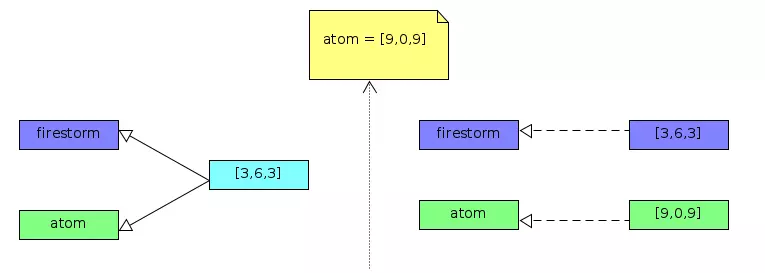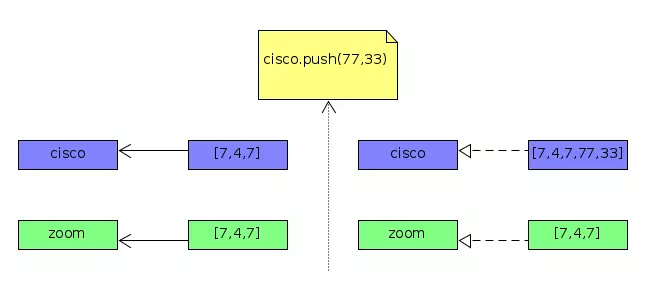Quick Tip: How JavaScript References Work
Understanding JavaScript References: A Deep Dive

Key Concepts:
- JavaScript uses pass-by-value for primitive types (Number, String, Boolean,
undefined,null, Symbol) and pass-by-reference for compound types (Objects and Arrays). Thetypeofoperator determines the assignment method. - References in JavaScript point directly to the data, not to other variables. Primitive values are immutable; compound values are mutable. Reassigning a compound value creates a new reference.
- When passing compound values to functions, changes within the function to the referenced data are reflected outside the function. However, reassigning the parameter within the function creates a new reference, leaving the original unchanged.
In short: JavaScript's reference behavior differs significantly from languages with explicit pointers. Only compound data structures are passed by reference.

Terminology:
- Scalar: A single data unit (e.g., integer, boolean).
- Compound: Multiple data units (e.g., array, object).
- Primitive: A direct value, not a reference.
Note: JavaScript's scalar types are primitives, unlike some languages (like Ruby) with scalar reference types. JavaScript's primitive values are immutable, while compound values are mutable.
This article was originally published on Medium.
Summary of Key Points:
- The
typeofoperator determines whether a value is assigned by value or by reference. - Primitives are assigned by value; compound values are assigned by reference.
- References point to data, not to other variables or references.
- Primitives are immutable; compound values are mutable.
Examples:
Pass-by-Value (Primitives):
let batman = 7; let superman = batman; //assign-by-value superman++; console.log(batman); //7 console.log(superman); //8

Pass-by-Reference (Compound Values):
let flash = [8, 8, 8]; let quicksilver = flash; //assign-by-reference quicksilver.push(0); console.log(flash); //[8, 8, 8, 0] console.log(quicksilver); //[8, 8, 8, 0]

Creating New References:
Reassigning a compound value creates a new reference:
let firestorm = [3, 6, 3]; let atom = firestorm; //assign-by-reference atom = [9, 0, 9]; //value is reassigned (creates new reference) console.log(firestorm); //[3, 6, 3] console.log(atom); //[9, 0, 9]

References in Functions:
let batman = 7; let superman = batman; //assign-by-value superman++; console.log(batman); //7 console.log(superman); //8
Modifying Original Compound Value within a Function:
let flash = [8, 8, 8]; let quicksilver = flash; //assign-by-reference quicksilver.push(0); console.log(flash); //[8, 8, 8, 0] console.log(quicksilver); //[8, 8, 8, 0]
Creating a Shallow Copy:
let firestorm = [3, 6, 3]; let atom = firestorm; //assign-by-reference atom = [9, 0, 9]; //value is reassigned (creates new reference) console.log(firestorm); //[3, 6, 3] console.log(atom); //[9, 0, 9]

Assigning Primitives by Reference (using Objects):
let magneto = [8, 4, 8];
(function(x) { //IIFE
x.push(99);
x = [1, 4, 1]; //reassign variable (creates new reference)
x.push(88);
})(magneto);
console.log(magneto); //[8, 4, 8, 99]Conclusion:

Understanding JavaScript's reference system is crucial for writing efficient and bug-free code.
(FAQs section omitted for brevity, but could be re-added based on need.)
The above is the detailed content of Quick Tip: How JavaScript References Work. For more information, please follow other related articles on the PHP Chinese website!

Hot AI Tools

Undresser.AI Undress
AI-powered app for creating realistic nude photos

AI Clothes Remover
Online AI tool for removing clothes from photos.

Undress AI Tool
Undress images for free

Clothoff.io
AI clothes remover

Video Face Swap
Swap faces in any video effortlessly with our completely free AI face swap tool!

Hot Article

Hot Tools

Notepad++7.3.1
Easy-to-use and free code editor

SublimeText3 Chinese version
Chinese version, very easy to use

Zend Studio 13.0.1
Powerful PHP integrated development environment

Dreamweaver CS6
Visual web development tools

SublimeText3 Mac version
God-level code editing software (SublimeText3)

Hot Topics
 1662
1662
 14
14
 1418
1418
 52
52
 1311
1311
 25
25
 1261
1261
 29
29
 1234
1234
 24
24
 Demystifying JavaScript: What It Does and Why It Matters
Apr 09, 2025 am 12:07 AM
Demystifying JavaScript: What It Does and Why It Matters
Apr 09, 2025 am 12:07 AM
JavaScript is the cornerstone of modern web development, and its main functions include event-driven programming, dynamic content generation and asynchronous programming. 1) Event-driven programming allows web pages to change dynamically according to user operations. 2) Dynamic content generation allows page content to be adjusted according to conditions. 3) Asynchronous programming ensures that the user interface is not blocked. JavaScript is widely used in web interaction, single-page application and server-side development, greatly improving the flexibility of user experience and cross-platform development.
 The Evolution of JavaScript: Current Trends and Future Prospects
Apr 10, 2025 am 09:33 AM
The Evolution of JavaScript: Current Trends and Future Prospects
Apr 10, 2025 am 09:33 AM
The latest trends in JavaScript include the rise of TypeScript, the popularity of modern frameworks and libraries, and the application of WebAssembly. Future prospects cover more powerful type systems, the development of server-side JavaScript, the expansion of artificial intelligence and machine learning, and the potential of IoT and edge computing.
 JavaScript Engines: Comparing Implementations
Apr 13, 2025 am 12:05 AM
JavaScript Engines: Comparing Implementations
Apr 13, 2025 am 12:05 AM
Different JavaScript engines have different effects when parsing and executing JavaScript code, because the implementation principles and optimization strategies of each engine differ. 1. Lexical analysis: convert source code into lexical unit. 2. Grammar analysis: Generate an abstract syntax tree. 3. Optimization and compilation: Generate machine code through the JIT compiler. 4. Execute: Run the machine code. V8 engine optimizes through instant compilation and hidden class, SpiderMonkey uses a type inference system, resulting in different performance performance on the same code.
 JavaScript: Exploring the Versatility of a Web Language
Apr 11, 2025 am 12:01 AM
JavaScript: Exploring the Versatility of a Web Language
Apr 11, 2025 am 12:01 AM
JavaScript is the core language of modern web development and is widely used for its diversity and flexibility. 1) Front-end development: build dynamic web pages and single-page applications through DOM operations and modern frameworks (such as React, Vue.js, Angular). 2) Server-side development: Node.js uses a non-blocking I/O model to handle high concurrency and real-time applications. 3) Mobile and desktop application development: cross-platform development is realized through ReactNative and Electron to improve development efficiency.
 Python vs. JavaScript: The Learning Curve and Ease of Use
Apr 16, 2025 am 12:12 AM
Python vs. JavaScript: The Learning Curve and Ease of Use
Apr 16, 2025 am 12:12 AM
Python is more suitable for beginners, with a smooth learning curve and concise syntax; JavaScript is suitable for front-end development, with a steep learning curve and flexible syntax. 1. Python syntax is intuitive and suitable for data science and back-end development. 2. JavaScript is flexible and widely used in front-end and server-side programming.
 How to Build a Multi-Tenant SaaS Application with Next.js (Frontend Integration)
Apr 11, 2025 am 08:22 AM
How to Build a Multi-Tenant SaaS Application with Next.js (Frontend Integration)
Apr 11, 2025 am 08:22 AM
This article demonstrates frontend integration with a backend secured by Permit, building a functional EdTech SaaS application using Next.js. The frontend fetches user permissions to control UI visibility and ensures API requests adhere to role-base
 From C/C to JavaScript: How It All Works
Apr 14, 2025 am 12:05 AM
From C/C to JavaScript: How It All Works
Apr 14, 2025 am 12:05 AM
The shift from C/C to JavaScript requires adapting to dynamic typing, garbage collection and asynchronous programming. 1) C/C is a statically typed language that requires manual memory management, while JavaScript is dynamically typed and garbage collection is automatically processed. 2) C/C needs to be compiled into machine code, while JavaScript is an interpreted language. 3) JavaScript introduces concepts such as closures, prototype chains and Promise, which enhances flexibility and asynchronous programming capabilities.
 Building a Multi-Tenant SaaS Application with Next.js (Backend Integration)
Apr 11, 2025 am 08:23 AM
Building a Multi-Tenant SaaS Application with Next.js (Backend Integration)
Apr 11, 2025 am 08:23 AM
I built a functional multi-tenant SaaS application (an EdTech app) with your everyday tech tool and you can do the same. First, what’s a multi-tenant SaaS application? Multi-tenant SaaS applications let you serve multiple customers from a sing




